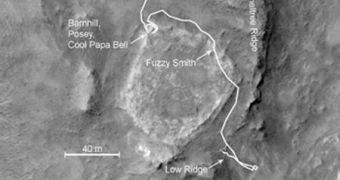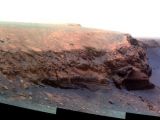MER-A or Martian Exploration Rover-A also known as Spirit is the first of the two Martian Exploration Rovers sent by NASA on the Red Planet, it has reached Mars in January 2004 and has continued to function over thirteen times longer than the expectations of NASA's engineers. The second one, MER-B, known as Opportunity, has landed on the other side of the planet.
Spirit has been exploring a plateau called Home Plate that is thought to have formed as a result of a volcanic eruption. Now the rover has begun a ride towards a nearby slope positioned 60 meters away from its current position, to prepare for the coming winter. Spirit has been experiencing difficulties to capture enough sunlight, since a dust storm raged on the planet's surface since July till August, which covered its solar panels with a fine coat of dust.
The dirty solar panels and the imminent winter have determined NASA to find a new way of producing the minimum necessary energy, to keep the rover operational. They have considered sending it to nearby sites that offered 20-degree slopes toward the north, to maximize the effective sunlight hitting the solar panels, but have recently decided to send the rover about 60 meters away onto a slope that will offer a 25-degree tilt. This was mainly decided because of the extra 5-degree angle which could provide Spirit with an extra 10 watt-hour of power per Martian day.
This was taken into consideration mostly for security reasons, while the rover Opportunity, based on the other side of the planet is being constantly cleaned by winds gusts; the region that Spirit is exploring usually has no wind, only occasional strong gusts.
The mission involving the repositioning is thought to be completed by January 2008, but the time that the rover will spent there mainly depends on the tilt the slope will ensure. "In the worst case, we have to be in place eight months or something" says rover chief scientist Steve Squyres of Cornell University in Ithaca, New York, US.
After the winter, Spirit will be sent to explore some intriguing geological features which lie beyond Home Plate, which include a steep-sided mesa, which seems to have an erosion resistant top and a strange hole in the ground that might have been created as a result of a volcanic explosion.
MER-B, Opportunity is currently scrutinizing a layer of rock inside Victoria Crater, resulted from a meteorite impact that exposed layers of bedrock 30 meters deep, deeper than anything the rover ever examined before. Opportunity equipped with an Alpha Particle X-Ray Spectrometer will also study the role of ground water at the site by digging into the rock with a rock abrasion tool or RAT.

 14 DAY TRIAL //
14 DAY TRIAL // 
